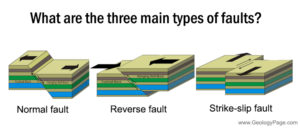Who was the scientist that discovered that continents seemed to fit together like a puzzle?
Alfred Wegener
What does the theory of plate tectonics say?
The theory of plate tectonics states that Earth's lithosphere is broken into distinct plates that are in constant motion.
What are the three types of stress forces that cause earthquakes?
Tension is the pulling and stretching found at divergent boundaries. Compression is the squeezing of rock until it bends - typically found at convergent boundaries - and shearing is when rock is pushed in two opposite directions until it breaks. This happens at transform boundaries.
What is the difference between magma and lava?
What does the p in p-wave stand for? What does the s in s-wave stand for. Which comes first?
P-waves are primary waves. They travel faster so they arrive first. S-waves are secondary waves. They arrive shortly after p waves.
What are three pieces of evidence that supported Wagener's theory that the continents were once connected?
Land features (they looked like they fit together), fossil evidence (fossils of a fernlike plant called Glossopteris found on five different continents), Climate (evidence that Earth's continents had experienced different climates than the ones they have today.
What are the two types of crust? Which one is more dense? Which one is thicker?
The two types of crust are continental crust and oceanic crust. Although continental crust is thicker, oceanic crust is more dense which is why it sinks at subduction zones.
In this fault, which color is will be the hanging wall and which color will be the footwall?
The hanging wall is the blue and the footwall is the green.
At which type of plate boundaries are volcanos most likely to happen? Do all volcanos happen at plate boundaries? What is an area where lava frequently erupts independent of plate boundaries called?
Volcanos tend to happen at divergent boundaries when plates move apart and rock rises to fill the empty space or at convergent boundaries where trapped water can leave the sinking plate and mix with material from the mantle.
Hot spot volcanos do not happen at plate boundaries.
What does the magnitude of an earthquake tell you?
The magnitude of an earthquake tells you how much energy the earthquake released.
At mid-ocean ridges, the seafloor spreads apart and molten rocks rises out of the cracks. It hardens into new rock on both sides of the crack.
What are the 3 types of plate boundaries? Explain each.
Divergent boundaries are places where plates are moving away from each other. Convergent boundaries are places where plates are moving toward each other. Transform boundaries are places there the plates slide past each other.
What kind of force creates each a normal fault, a reverse fault and a strike-slip fault?
Compare the 4 types of volcanos? What type of volcanos are hot spot volcanos?
Composite volcanos are cone shaped and tall. They have layers of lava and ash. Cinder cone volcanos are make of loose ash that erodes quickly. Lava plateaus happen when lava flows out of several cracks in the Earth's crust. They are relatively flat. Shield volcanos have slow steady eruptions over a broad area. They are massive.
Hotspot volcanos are shield volcanos.
Why does oceanic crust sink at subduction zones found at ocean trenches?
Oceanic crust is more dense than continental crust.
Why don't mid-ocean ridges cause the ocean to get wider overall?
At ocean trenches oceanic crust goes back into the mantle and melts in a process called subduction.
What type of boundary are mid-ocean ridges? What type of boundary are subduction zones?
Mid-ocean ridges are found at divergent boundaries. Subduction zones are found at convergent boundaries.
When compression causes the crust to deform without breaking, what landforms result?
Mountains are formed from compression.
What is a caldera?
A caldera is a large depression formed when a volcano erupts and collapses.
What happens if two continental crusts meet at a convergent boundary? What happens if two oceanic crust meet? What happens if a continetal and an oceanic crust meet at a convergent boundary?
When two continental crusts meet, mountains are formed. When two oceanic rusts meet, whichever one is older, colder, and more dense will sink. When oceanic and continental crusts meet, the oceanic crust will sink below the continental crust because it is more dense.
Draw a picture of sea-floor spreading. Label the mid-ocean ridge, the ocean trenches, the newest rock and the oldest rock.

Explain how convection drives the motion of plates.
Molten rock flows in slow moving currents. Warm magma heated by the Earth's interior rises while colder and harder rock from the crust will sink. The cycle repeats causing convection currents.

Explain the process scientists use to find the epicenter of an earthquake.
They use the difference in arrival time of p and s waves to determine the distance an earthquake is from a seismograph station. They then mark that distance in every direction from the station, forming a circle around the station. They need data from 3 different stations to find the precise location of epicenter of an earthquake. The location where all three circles overlap.
What factors determine how a volcano will erupt.
Whether an eruption is quiet or explosive depends on the magma's silica content and whether the magma is thin and runny or thick and sticky.
If the magma chapter is hot or low in silica, the eruption will be gentle with thin and runny lava. Magma that has a lot of silica will erupt more explosively. High silica magma is thick and sticky causing it to build up pressure.
What are the three types of faults? Explain each in words or pictures.
The three types of faults are normal, reverse and strike slip. In a normal fault the hanging wall slides down in relation to the footwall. In a reverse fault, the footwall slips down and in a strike-slip fault the two walls slide past each other.
